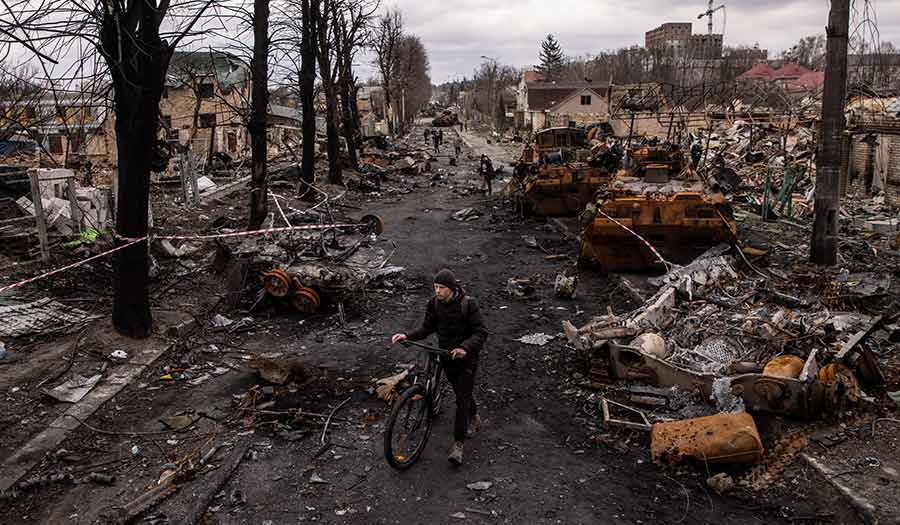 Chris McGrath/Getty Images
Chris McGrath/Getty Images
Article
Part 2 of our Population Boom series examines how the surge in human growth impacts the scourge of war.
 Chris McGrath/Getty Images
A man pushes his bike through debris and destroyed Russian military vehicles on a street in Bucha, Ukraine.
Chris McGrath/Getty Images
A man pushes his bike through debris and destroyed Russian military vehicles on a street in Bucha, Ukraine.
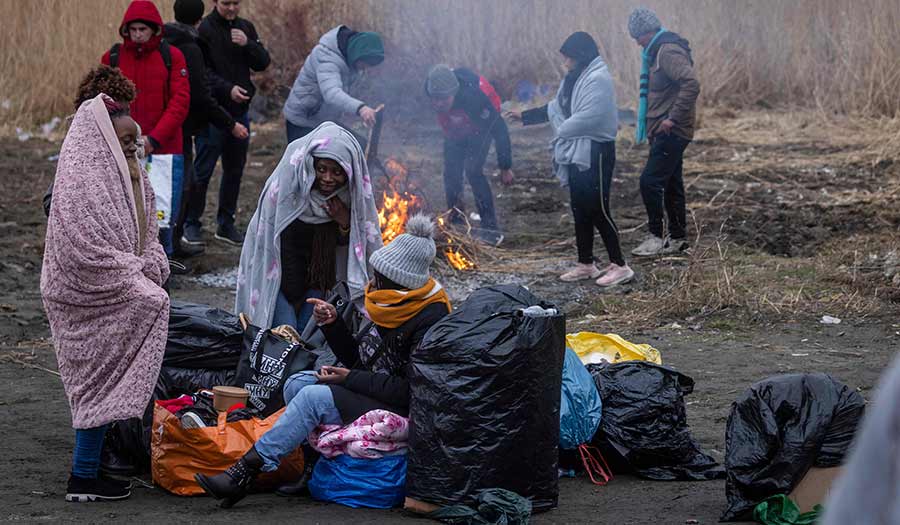 Wojtek Radwanski/AFP via Getty Images
Students of Ukrainian universities fleeing the war gather at the Medykapedestrian border in eastern Poland (Feb. 27, 2022).
Wojtek Radwanski/AFP via Getty Images
Students of Ukrainian universities fleeing the war gather at the Medykapedestrian border in eastern Poland (Feb. 27, 2022).
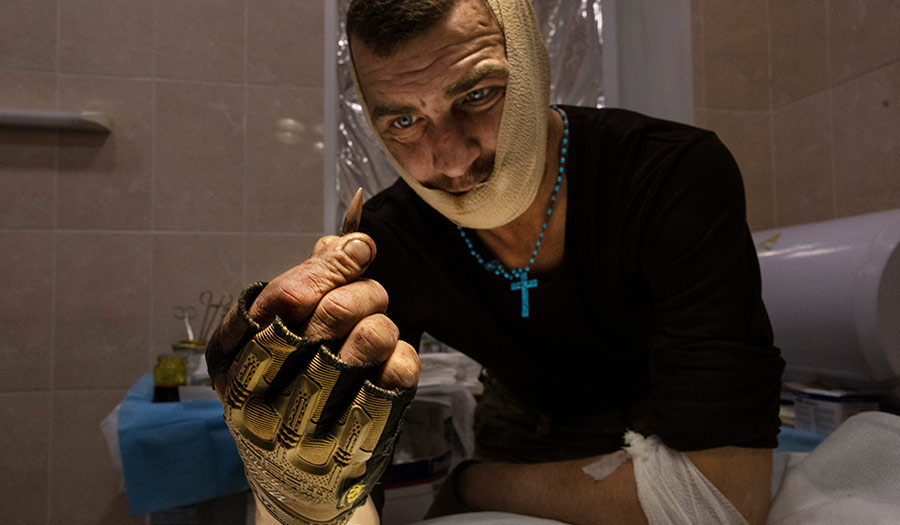 Paula Bronstein/Getty Images
A Ukrainian soldier looks at the bullet that was lodged in his chin after a successful operation at a hospital in Donetsk District, Ukraine (Oct. 9, 2022).
Paula Bronstein/Getty Images
A Ukrainian soldier looks at the bullet that was lodged in his chin after a successful operation at a hospital in Donetsk District, Ukraine (Oct. 9, 2022).
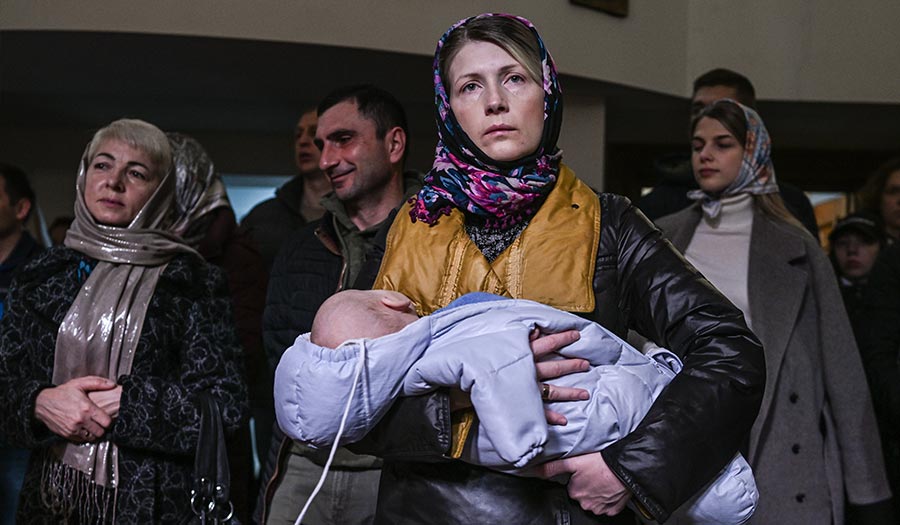 Omar Marques/Getty Images
A woman holds her baby among people who fled the war in Ukraine and members of the Ukrainian diaspora during Mass in Krakow’s Orthodox church in Poland (April 3, 2022).
Omar Marques/Getty Images
A woman holds her baby among people who fled the war in Ukraine and members of the Ukrainian diaspora during Mass in Krakow’s Orthodox church in Poland (April 3, 2022).
 Christopher Furlong/Getty Images
A destroyed Russian battle tank lays amid other armored vehicles beside a road in Irpin,Ukraine (May 25, 2022).
Christopher Furlong/Getty Images
A destroyed Russian battle tank lays amid other armored vehicles beside a road in Irpin,Ukraine (May 25, 2022).
2022 was the year war returned to Europe, and few facets of life were left untouched.
Russia’s invasion of its neighbor Ukraine unleashed misery on millions of Ukrainians, shattered Europe’s sense of security, and made life more expensive in homes across Europe.
Yet the shockwaves of the conflict revealed just how interconnected our world of 8 billion people has become. Russia’s military move ripped up the geopolitical map, rocked the global economy and worsened the world’s migrant crisis.
“What do we hear today? It’s not just rocket explosions, battles, the roar of aircraft. It is the sound of a new Iron Curtain lowering and closing Russia away from the civilized world,” Ukrainian President Volodymyr Zelenskyy said as the invasion began.
Russia’s pre-dawn attack on February 24 shattered European peace and shocked the world. The war also confounded the near-universal expectation that Russian forces would quickly prevail. Ukraine put up fierce resistance, and Russian troops bogged down on the journey to the capital. Russia pulled back from the area around Kyiv in April, leaving blasted buildings, traumatized people, and hundreds of corpses that Ukraine and its allies say are evidence of war crimes.
The war revived Cold War-era enmity between Russia and the West, pushing Sweden and Finland to seek NATO membership and prompting NATO nations to flood troops and weapons into eastern Europe.
As winter approached, Ukraine’s military—bolstered by weapons, ammunition and training from the U.S. and other allies—pushed Russian forces out of the southern city of Kherson, a morale-boosting victory amid a grinding war that showed no sign of ending.
The war also sent global energy prices soaring as Moscow squeezed supplies to the West in retaliation for sanctions on Russia and support for Ukraine. Italy, Germany and other countries that relied on Russian oil and natural gas scrambled for alternative energy supplies. With millions of people suddenly struggling to pay their energy bills, governments came under intense pressure to step in with help.
Ukraine and Russia are key global suppliers of wheat, barley, sunflower oil and—in Russia’s case—fertilizer, and the war also drove up food prices and raised fears of global shortages. A UN-brokered deal to allow grain ships to leave Ukraine’s Black Sea ports was struck in July and, though shaky, held to prevent a worse crisis.
The war added millions to the world’s grim tally of displaced people. More than 14 million Ukrainians left their homes, according to the UN, with 7 million taking refuge in other countries.
Meanwhile, almost 100,000 people fleeing conflict and poverty in the Middle East, Asia and Africa crossed the Mediterranean in overcrowded and sometimes unseaworthy vessels, as the European countries they aimed to reach bickered over where they should go. More than 2,000 people died attempting the journey or were missing at sea.
The English Channel became another flashpoint, as smuggling gangs packed dinghies and other small boats with people from around the world who traveled to northern France in hope of reaching the UK. More than 40,000 succeeded in 2022. In response, the Conservative British government signed a deal with Rwanda to send people arriving by this route on a one-way trip to the east African country.
Yet the Russia-Ukraine War revealed another problem of having 8 billion people on Earth: Having to choose which emergencies need aid money the most.
The war in Ukraine abruptly drew millions of dollars away from other long-standing crises. Somalia, facing a food shortage largely driven by the war, was perhaps the most vulnerable.
Come July, Somalia’s aid funding was less than half of 2021’s level while overwhelmingly Western donors had sent more than $1.7 billion to respond to the war in Europe. Yemen, Syria, Iraq, South Sudan, Congo and the Palestinian territories were similarly affected.
These areas all have their own military conflicts that send negative ripple effects to surrounding nations and abroad.
“After the Taliban last year took control in Afghanistan, nations around the world imposed sanctions and cut off aid, leading to a severe food shortage in the country,” Deutsche Welle reported. “Ongoing civil wars in Yemen, Ethiopia and Myanmar have also triggered acute food shortages and displaced millions over the past years.
“And since Russia invaded Ukraine in late February, the gap between the funds required to respond to these crises versus the amount actually raised has widened.”
At the end of 2022, the war in Ukraine’s true toll on funding became clear. The United Nations Office for the Coordination of Humanitarian Affairs said its appeal for humanitarian support to Ukraine reached 52.5 percent of the targeted $6.14 billion.
For Yemen, only 46 percent of the $4.2 billion humanitarian response plan has been funded and 48 percent for Afghanistan’s required $4.4 billion. In 2021, Yemen had 51 percent funded and Afghanistan had over 100 percent funded in a flash appeal.
And the gap between funds needed and what is met is growing. In 2016, 53 percent of global appeals were funded of about $20 billion. In 2022, just 37 percent was funded of $51.7 billion requested.
The series continues in Part 3: Billion-Dollar Disasters
This article contains information from Reuters and The Associated Press.
- Real Truth Magazine Articles
- WEATHER & ENVIRONMENT
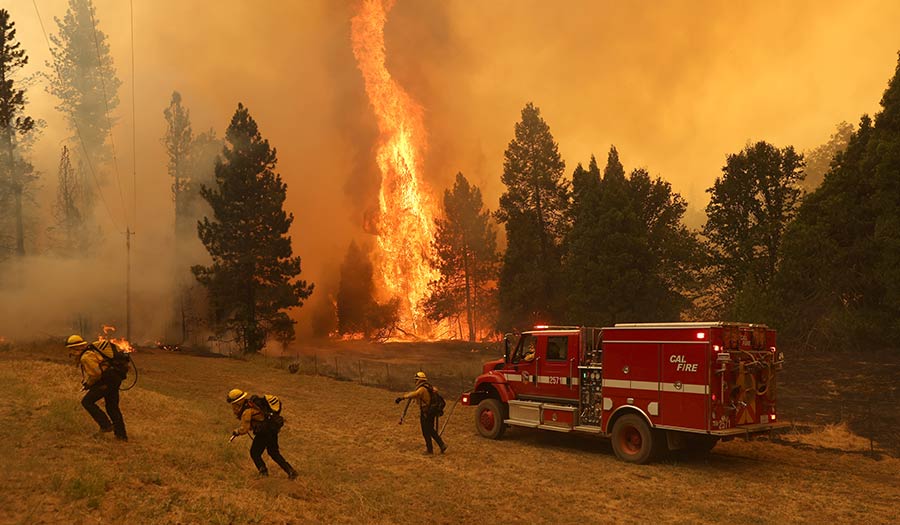 Billion-Dollar Disasters
Billion-Dollar Disasters


